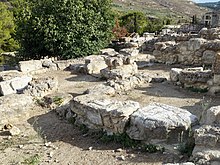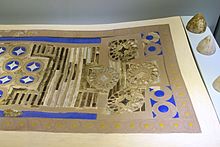Game board from Knossos

The game board of Knossos ( Greek Ζατρίκιον Zatrikion , board game ') describes an archaeological artifact that was found in 1900 by Arthur Evans during his excavations in the palace of Knossos on Crete . It is dated from 1700 to 1450 BC. Dated to the Minoan New Palace period. The find is now in the Archaeological Museum of Heraklion .
Find description
Coordinates of the place of discovery: 35 ° 17 ′ 53.1 ″ N , 25 ° 9 ′ 48.8 ″ E
The find discovered in the year of the beginning of the systematic excavations in Knossos (March 1900) was referred to by Arthur Evans as the Royal Gaming Board and in his article The Palace of Knossos in Volume 7 of the Annual of the British School at Athens by Described in 1901. Although it is not certain whether it is actually a "game board" for use in a board game , the found object was later given similar names, such as "chess-like king game", "chess game of Knossos" or "Zatrikion". In the Archaeological Museum of Heraklion the find is shown as Ζατρίκιο (Zatrikio) and in English as a Draugthboard . The site in the northeast area of the Palace of Knossos is known as the "corridor of the game of chess".
The "game board" as a whole is 96.5 cm long and 55.3 cm wide. It was found almost completely preserved about 70 cm below the surface of the earth in the corridor later named after him, about opposite the beginning of the northeast stairs. The outer edge and parts of the interior of the find were broken off, but could be reconstructed with the abundant fragments.
The ivory "game board" probably formed the top of a wooden box. It is provided with inlays made of rock crystal and lapis lazuli- blue glass and partly covered with gold and silver foil. The frame is represented by 72 daisy flowers . On one side there are four large, circular medallions arranged in a cross shape, the outer sides of which each fill a pair of counter-rotating spirals. The medallions have an outer loop ring made of ivory with silver-backed glass and rock crystal inlays and in the core each a diamond with drawn-in sides. On the other side of the medallions there is an H-shaped zone made of alternating flat rock crystal and rounded ivory strips. The opposite side of the "game board" is filled with ten smaller diamond circles, divided into a central group of four and two rows of three on the side. The space between the last four circles of the three rows consists of ivory and rock crystal strips.
In order to underpin his interpretation as a “royal game board”, Evans attempted to reflect on the way the game was played. The aim of two players could have been to take the “citadel” of the four medallions with perhaps four “game pieces”, probably with dice. Four conical ivory objects (height 73 - 82 mm, diameter 80 - 82 mm), which correspond to the diameter of the fields of the group of ten of the "game board" (88 mm) and were found nearby, support the idiosyncratic arrangement that contradicts the mere ornamentation of a wooden box lid of fields Evans assumption.
The doubts expressed by Harold JR Murray in 1952 that anything could be played on this board was countered by Robert S. Brumbaugh in 1975 with his attempt to show a similarity between the Minoan "game board" and the royal game of Ur , of which several boards look alike were found in the royal tombs of the Sumerian city of Ur . The latter is possibly related to the ancient Egyptian game Senet , which in turn resembles the twenty-field game introduced by the Hyksos to Egypt . The "game board" from Knossos differs from the other games in that it does not have continuous playing fields, where each field is directly adjacent to an adjacent one. The gap between the ten smaller fields and the four medallions, which already irritated Murray, makes it a unique specimen among all game boards known from ancient high cultures.
literature
- Arthur Evans : The Palace of Knossos . In: The Annual of the British School at Athens . tape 7 , 1901, The Royal Gaming Board, pp. 77–82 (English, digitized version ).
- Arthur Evans: The Palace of Minos . tape 1 . Macmillan, London 1921, pp. 463-485 (English, digitized version ).
- Robert S. Brumbaugh: The Knossos Game Board . In: American Journal of Archeology . tape 79 , no. 2 , 1975, p. 135-137 , JSTOR : 503893 (English, digitized ).
- Ulrich Schädler : Playing in the Minotaur's labyrinth? In: Fachdienst Spiel . No. 2/96 , 1996, p. 6-14 ( digitized version ).
Individual evidence
- ↑ Arthur Evans: The Palace of Knossos . In: The Annual of the British School at Athens . tape 7 , 1901, The Royal Gaming Board, pp. 77–82 (English, digitized version ).
- ↑ Jorgos Tzorakis: Knossos: New guide to the palace of Knossos . Esperos, Athens 2008, ISBN 978-960-8103-66-5 , pp. 42 and 89-92 .
- ↑ Arthur Evans: The Palace of Minos . tape 1 . Macmillan, London 1921, pp. 473 (English, digitized version ).
- ↑ Arthur Evans: The Palace of Knossos . In: The Annual of the British School at Athens . tape 7 , 1901, The Royal Gaming Board, pp. 77-78 (English, digitized version ).
- ↑ Ulrich Schädler: Playing in the Minotaur's Labyrinth? In: Fachdienst Spiel . No. 2/96 , 1996, p. 7 ( digitized version ).
- ↑ a b Ulrich Schädler: Playing in the Minotaur's labyrinth? In: Fachdienst Spiel . No. 2/96 , 1996, p. 8–9 ( digitized version ).
- ↑ Harold James Ruthven Murray: A History of Board Games other than Chess . Clarendon Press, Oxford 1952, pp. 23 ff . (English).
- ^ Robert S. Brumbaugh: The Knossos Game Board . In: American Journal of Archeology . tape 79 , no. 2 , 1975, p. 135-137 , JSTOR : 503893 (English, digitized ).
Web links
- Game board. Prometheus (University of Cologne), accessed on May 5, 2017 .
- Christos Z. Konstas: Σαν Παιχνίδι. In: Η Αρχαιοελληνική Βίβλος των Νεκρών. ΑΡΧΕΤΥΠΟ, 2007, Retrieved May 5, 2017 (Greek).


